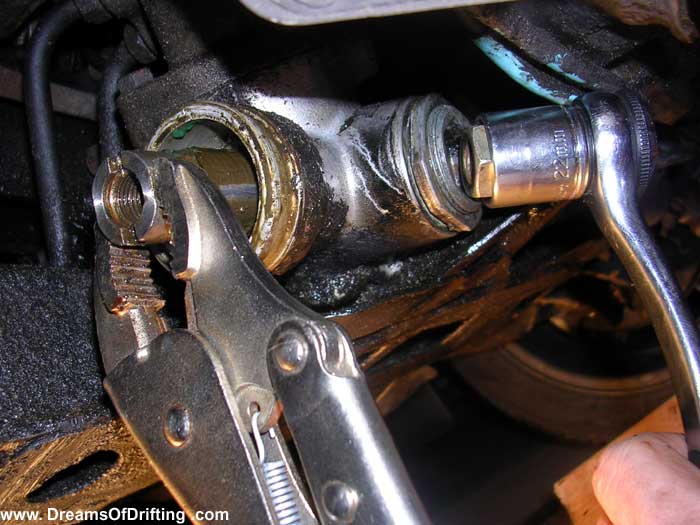





 |
|

Adjusting the preload while wiggling
the end of the rack
Have a clunk or excessive play in your steering?
I've had a noticeable clunk in my steering rack for
around 6 months now, and I finally traced the problem specifically to the rack
preload adjustment.
If that sounds confusing, here's a quick
explanation:
Over the years the rack loosens up a little in the
housing, so you have to tighten the pressure that is applied to hold it firmly
in the housing. When it loosens up, the rack will actually twist as the teeth
engage into it, which is where the clunking and play comes from (in addition to
any worn out tie rod ends).
The adjustment for this is at the back of the rack, just under the main input
shaft/u-joint. It takes about 5 minutes once you've got the car jacked up and
the wheel removed.
Take a look at the pictures on the left...
The part that you adjust to apply pressure is
the one you see with the large hole for an allen key. Chances are you don't have
a 24mm allen key, but I made due with a 22mm crown bolt I had laying around.
Once you loosen the lock nut (that thin squared nut sitting around the adjusting
screw), you'll need very little force to turn the adjusting screw, which is why
you can get away with using a 22mm bolt.
If you have a look at the close up shot of the
adjusting screw, you'll be able to see a divot (small hole) that has been
pierced into the threads preventing you from turning the adjusting screw inward
any further than it already is. I'm sure this was a great safeguard 20 years ago
when the rack was brand new, but now that you need that adjusting screw to push
a little deeper into the rack, it can be a problem.
My solution was to grab a washer that best fit the
diameter of the adjusting screw, which still allowed the spring to sit in the
middle. The washer I used is from an OEM Toyota aluminum wheel lug nut. By doing
this, I'm pushing the adjusting screw outward, and it will free up the threads I
need to properly adjust the rack. I lubed both sides of the washer with brake
caliper grease.
When making the adjustment, keep a pair of vise
grips secured to the end of the steering rack. If you can wiggle it clockwise
and counterclockwise, it means you need to tighten the preload of the rack
(screw the adjusting screw in). The idea here is to remove as much play from the
rack as possible, but just enough so that your steering wheel still turns
without any additional effort.
When I made my first adjustment, I set the preload
too high, and when I went on my test drive, the steering wheel actually stuck in
a turned position when I went around the corner, instead of easily straightening
itself out as usual, so I had to manually turn the wheels back into a straight
position to avoid doing a donut.
Once you think the adjustment is correct, and
you're ready to go for a test drive, be sure to tighten that thin squared lock
nut that sits around the adjusting screw!
I can already tell that this one of the most
beneficial repairs I've ever made to the car. The steering is incredible! I
can't wait for the next Autocross and Drifting event!
Good luck!
-Migs
Dreams of Drifting
Copyright © 01/2000 Chris Migs
all
rights reserved
|
|
The Benefits?
In over 5 years of owning and driving AE86's, I
have never enjoyed such precise and accurate steering. I always wondered my
steering never felt as I thought it should, but always assumed it was it just a
matter of the rack being worn out.
I'm honestly upset that I didn't know about doing
this sooner, as it would have made a huge impact on my learning curve with the
car. OH well!
*NOTE*
Keep in mind, having a tight rack means that you'll
be wearing the rack out faster than if you had left it loose, or adjusted it
with just a liiiiittle bit of play. So be sure not to set the preload too high!
 |